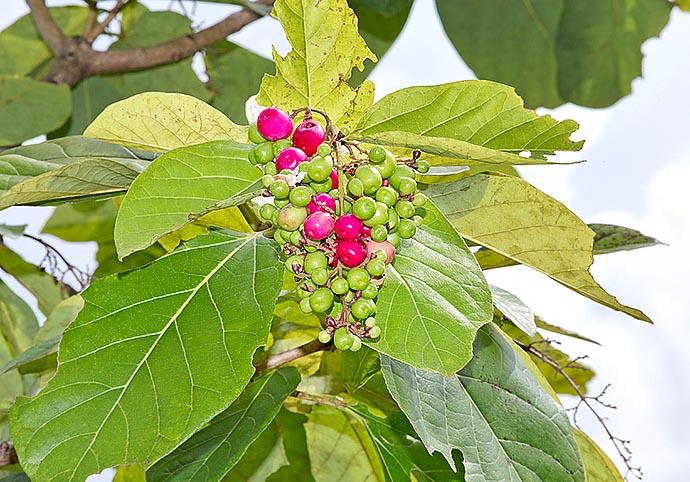Family : Lamiaceae

Text © Pietro Puccio

English translation by Mario Beltramini

The Gmelina macrophylla grows spontaneously in Queensland and New Guinea where can be 35 m tall. Terminal 15-30 cm panicle inflorescences with white-pinkish corollas and showy obovoid not edible drupes often exceeding 2 cm © G. Mazza
The species is native to Australia (Queensland) and New Guinea where it lives at the margins of the pluvial forests or in swampy areas up to about 500 m of altitude.
The genus was honoured by Linnaeus to the German physician and botanist Johann Georg Gmelin (1709-1755); the specific name is the combination of the Greek adjective “μακρός” (macrόs) = big, long and of the substantive “φύλλον” (phyllon) = leaf with obvious reference.
Common names: grey teak, white beech (English).
The Gmelina macrophylla (R. Br.) Benth. (1870) is a shrub or an up to about 35 m tall tree with erect trunk, of 10-50 cm of diameter, with greyish bark vertically fissured. The leaves, on a 1-3 cm long grooved petiole, are simple, opposite, oblong-ovate with entire margin and obtuse or pointed apex, 10-35 cm long and 8-22 cm broad, coriaceous, of dark green colour above, pale green or green grey below, equipped in the lower page of two nectariferous glands placed close to the petiole on the sides of the central nervation.
Terminal panicle inflorescences, 15-30 cm long, bearing numerous hermaphroditic subsessile flowers, of white, white-pinkish or purple pink colour, with campanulate calyx slightly lobed, 0,5 cm long, provided of blackish nectariferous glands on the outer surface, persistent and slightly enlarged in fruit. Bilabiate tubulose corolla, 1,5-2,5 cm long, bilobed upper labrum, oblong lobes about 0,8 cm long and 0,4 cm broad; trilobed lower labrum, oblong-ovate lateral lobes, 0,5-0,8 cm long and 0,4 cm broad, oblong central lobe, about 1 cm long and 0,5 cm broad, of intense pink or mauve colour with yellow spot at the base.
The fruits are obovoid drupes truncated at the apex, 1,2-2,3 cm long and of 0,8-2 cm of diameter, initially green, then glossy pink-red when ripe, white pulp that quickly oxidizes to air, of bitter taste not edible, and woody endocarp containing 1-5 seeds.
It reproduces by seed in organic loam with addition of sand or perlite per a 30% maintained humid at the temperature of 24-26 °C. Ornamental species thanks to the foliage and the coloured infructescences, but almost unknown outside the origin areas, suitable for parks and gardens of the tropical and subtropical climate zones, requires an exposition in full sun or a slight shade and draining soils, preferably sandy, rich of organic substance, maintained almost constantly humid.
The wood, of good quality, durable and rather coarse grained, is utilized in the constructions, for floors and boards, for inner parts of boats, furniture and handicrafts.
Synonyms: Vitex macrophylla R.Br. (1810); Vitex dalrympleana F.Muell. (1864); Ephialis simplicifolia Sol. ex Seem. (1865); Gmelina dalrympleana (F.Muell.) H.J.Lam (1919).
→ To appreciate the biodiversity within the family LAMIACEAE please click here.
